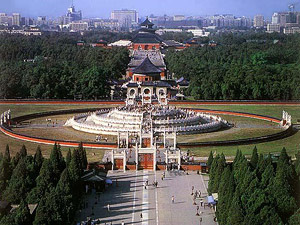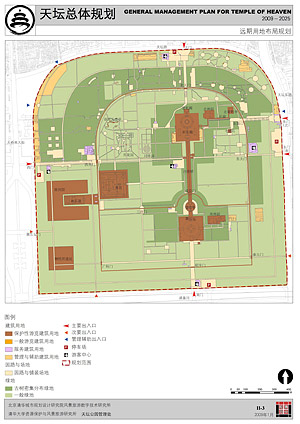best practices > sample project summaries
The Temple of Heaven
Cultural Landscape Type: Evolved Relict, Associative
Project Name: General Management Plan for the Temple of Heaven
Project Type: Planning Project, Comprehensive Master Plan and Management Plan
Location: Beijing, People’s Republic of China, 39°52'56.32"N, 116°24'23.86"E
Cultural Landscape Size: 273 ha
Property Owner/Steward: People’s Republic of China/ the Administration Department of the Temple of Heaven
Funding: Beijing Municipal Administration Center of Parks
Relevant Historical Dates: first established in A.D. 1420
Historic Landscape Architect, Designers: N/A
Contact: YANG Rui; Chair and Professor, Department of Landscape Architecture, Tsinghua University; 0086- 62797027; [email protected]


Project Description:
The Temple of Heaven is a World Heritage Site and a Cultural Heritage under National Protection with high values of cultural relics and historical researches. It was first established in Ming Dynasty (1420 A.D.) and rebuilt many times during the following dynasties. It combines of 5 main building ensembles which are encircled by 2 rings of altar walls. The buildings and plants were all arranged with symbol meanings. Being the greatest temple for worshiping heaven, it was the altar of ancient Chinese emperors and is the most outstanding material representative to show the Chinese philosophic thinking of Harmony between Human and Nature. Its special layout, grand buildings, verdant old trees, abundant relics and etc. have high values on history, culture, science, art and ecology.
This project is a general plan for the Temple of Heaven focusing on its protection and management. From 1735 questionnaires, 15 times of site investigations and about 40 stakeholders’ interviews or meetings, we conclude 4 key problems and 5 theme problems for the current status of the Temple of Heaven. And considering these problems with the heritage’s historical position and abundant values, we decide the plan targets system and 7 plan strategies, define the plan structure and the site layout, make the management zoning and relevant management policies. On the basis we formulate the theme plan such as heritage protection, planting plan, tourist management, explanation and interpretation plan, road and transportation plan, managing buildings plan, infrastructure plan, public safety plan and scientist research plan. Further more we give the action plan for the near future and provide the relevant ensuring measures.

. . .deterioration or disappearance of any item of the cultural or natural heritage constitutes a harmful impoverishment of the heritage of all the nations of the world.
World Heritage Convention Concerning the Protection of the World Cultural and Natural Heritage, 1972

